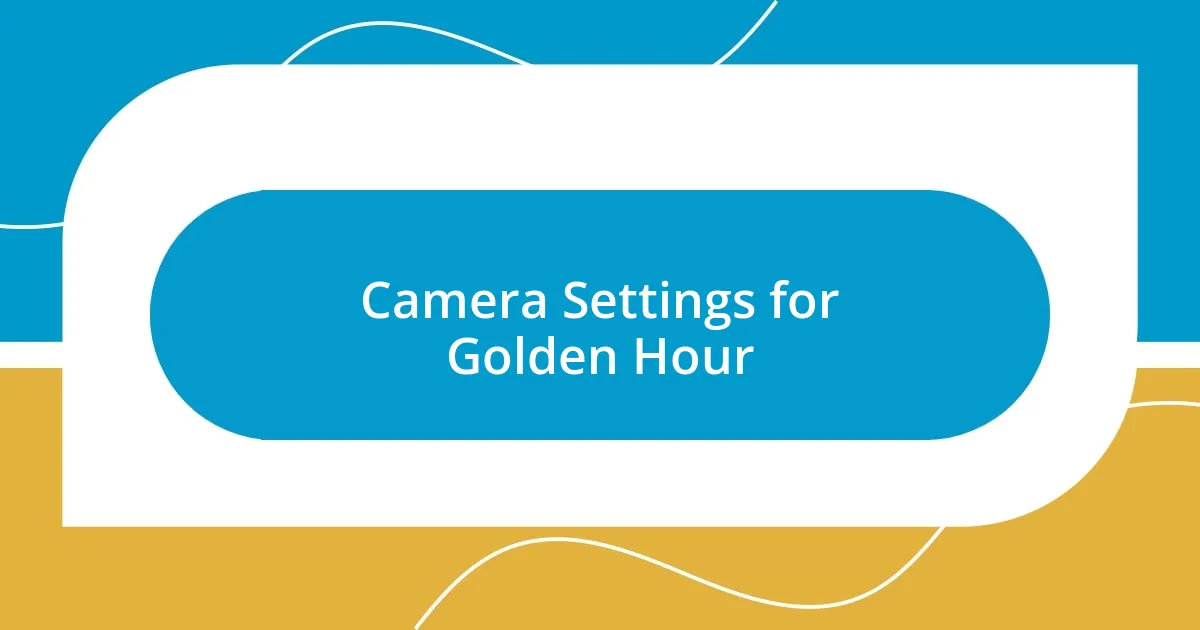Key takeaways:
- Golden hour occurs shortly after sunrise or before sunset, providing soft, warm light that enhances textures, colors, and emotional depth in photography.
- Effective lighting is crucial in photography; it influences mood, reveals details, and adds depth to images, especially during the golden hour.
- Optimal golden hour times vary by season, typically 30-60 minutes after sunrise and before sunset; planning is essential for best results.
- Key camera settings for golden hour include a low ISO (100-400), a wide aperture (f/2.8 or f/4), and a fast shutter speed (at least 1/125s) to capture sharp images in magical lighting.

Understanding Golden Hour Photography
Golden hour photography is that magical time shortly after sunrise or before sunset when the light softens and takes on a warm, golden hue. I remember the first time I stumbled upon this phenomenon; the sky was painted in shades of orange and pink, and I felt like I had stepped into a dream. Isn’t it incredible how such fleeting moments can transform ordinary scenes into stunning visuals?
The beauty of golden hour lies not just in the light but also in how it enhances textures and colors, adding depth to your images. Personally, I find that this time of day brings out emotions in my subjects that might be hidden in harsher daylight. Have you ever noticed how a gentle glow can make smiles seem brighter?
What excites me most is the versatility that golden hour offers. Whether you’re capturing landscapes, portraits, or still life, that warm light provides a unique atmosphere that’s hard to replicate. I often think back to a portrait session I did during golden hour; the natural light made my subject appear ethereal. It begs the question: why wouldn’t every photographer chase these golden moments?

Importance of Lighting in Photography
The role of lighting in photography cannot be overstated. It’s the element that can make or break your shot. I remember a day when I ventured out for a casual walk with my camera, and I faced an overcast sky. I found myself struggling to capture the vibrancy of what I saw. That experience made me realize just how critical it is to understand and utilize lighting effectively.
When you tap into the power of light, especially during the golden hour, your photography transforms. Here are some reasons why lighting is so important:
- Mood Creation: Different lighting conditions can evoke varying emotions. The soft light of golden hour brings a sense of warmth and tranquility, creating a mood that resonates with viewers.
- Texture and Detail: Good lighting reveals the intricate textures of your subjects. I’ve noticed that the gentle light during this time enhances details in nature, making leaves look more vibrant and inviting.
- Color Dynamics: The hues during golden hour are unique. They can make colors pop in a way that harsh daylight simply can’t.
- Depth and Dimension: Well-placed light can create shadows that add depth to your images. This dimensionality draws the viewer’s eye and invites them into the frame.
Understanding and harnessing lighting is a game changer for any photographer. From my experience, it’s all about embracing those brief moments when light works its magic.

Best Times for Golden Hour
When it comes to capturing those beautiful golden hour moments, timing is everything. Typically, the best times for golden hour photography are about 30 to 60 minutes after sunrise and 30 to 60 minutes before sunset. I remember one memorable evening where I made it just in time to see the sun dipping low, casting a warm glow over everything. Those minutes felt like pure magic, and the way the light wrapped around my subject was breathtaking. Have you ever felt that thrill as the world transforms before your eyes?
Interestingly, the exact timing of golden hour varies based on your location and the time of year. I often find myself checking golden hour apps or websites to plan my shoots. There’s something so rewarding about being prepared and witnessing how the light interacts with different elements in the landscape. For instance, in winter months, the golden hour might come earlier, giving you a chance to capture a snowy scene illuminated by that beautiful amber light. Have you found the golden hour to be a game-changer in your photography sessions?
Here’s a quick comparison table to give you a clearer idea of when those optimal times are likely to happen:
| Season | Morning Golden Hour | Evening Golden Hour |
|---|---|---|
| Spring | 5:30 AM – 6:30 AM | 6:30 PM – 7:30 PM |
| Summer | 5:00 AM – 6:00 AM | 7:45 PM – 8:45 PM |
| Fall | 6:00 AM – 7:00 AM | 5:30 PM – 6:30 PM |
| Winter | 7:00 AM – 8:00 AM | 4:30 PM – 5:30 PM |

Ideal Locations for Golden Hour
Finding the right location for golden hour photography can significantly enhance the magic of your images. I’ve discovered that beaches provide a breathtaking backdrop, where the sun melts into the ocean. The reflections on the water create a stunning interplay of light and color. Who wouldn’t be captivated by those moments when the sky transforms into a canvas of oranges and purples?
Another ideal spot I enjoy is a lush, open field. With tall grass swaying in the breeze, the golden hour light dances through the blades, creating beautiful highlights and shadows. I once spent an evening in a serene meadow, and it felt like I was in a dream. The way the setting sun kissed the land made everything feel alive and vibrant. Have you ever experienced such tranquility in nature while capturing light at its best?
Urban environments can also be fantastic for golden hour photography. I often wander the streets of my city, looking for interesting architecture and bustling life framed against that warm glow. One memorable day, I captured a photo of a busy cafe with golden light streaming through the windows. It brought a sense of warmth and connection to the city vibe. Have you thought about how urban settings can transform during golden hour? The possibilities are truly endless.

Camera Settings for Golden Hour
When it comes to camera settings for golden hour, I always emphasize using a low ISO. Ideally, I recommend setting your ISO between 100 and 400, which not only minimizes noise but also makes the most of that soft, warm light. I remember the first time I shot outside at sunset with a lower ISO—it made the colors pop in ways I had never seen before. It’s incredible how a simple adjustment can transform your images.
Aperture is another crucial setting during golden hour. I often shoot with a wide aperture, like f/2.8 or f/4, to create that beautiful bokeh effect. It helps to characterize your subject, letting the surrounding warm light blur gently into the background. I cherish one evening where I shot a portrait of a friend against a sunlit backdrop. The way the light wrapped around her gave the photo a dream-like quality. Have you ever played around with aperture settings and noticed the difference it makes?
Don’t overlook shutter speed; it’s essential to prevent motion blur when capturing fleeting moments at golden hour. I usually aim for a shutter speed of at least 1/125s, especially if I’m photographing people or moving subjects. There was a fascinating moment when I was at a park during golden hour, capturing kids playing. I increased my shutter speed to keep the images sharp, and the result was stunning—every joyous expression was crystal clear. What settings have you found work best for you during those magical minutes of light?

Tips for Capturing Stunning Images
When capturing stunning golden hour images, composition is key. I always remind myself to embrace the rule of thirds; it’s a technique that can really elevate your photographs. On a recent golden hour shoot, I framed the setting sun off-center with a silhouette of a tree on the opposite side. The resulting image was visually striking and told a beautiful story. Have you experimented with composition to discover how it can change the whole vibe of your photos?
Additionally, I find that focusing on the light direction can make a massive difference in the mood of your shots. I often try to position myself so that the light hits my subject from the side or behind. One unforgettable moment was capturing a friend walking along the beach with the sun at her back, casting a lovely halo effect around her. It felt almost magical, as if the scene came alive with emotion. How do you typically use the sun’s position to enhance your photos?
Sometimes, it’s the little details that truly make an image pop. I always keep an eye out for reflections or foreground elements that can create depth. Just the other day, I stumbled upon a puddle that was mirroring the vibrant sky during golden hour. I crouched down low, capturing a unique perspective that transformed a simple landscape into a compelling image. What unique angles have you discovered that add an unexpected twist to your photography?














